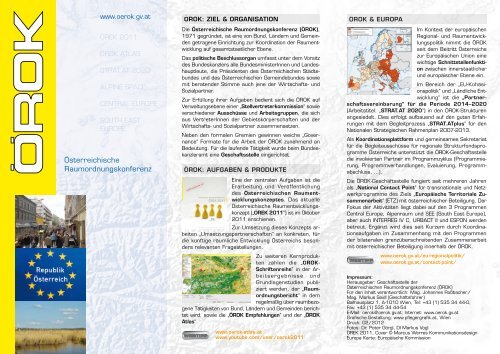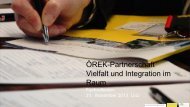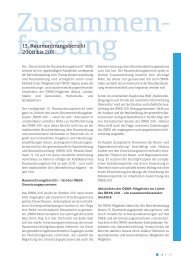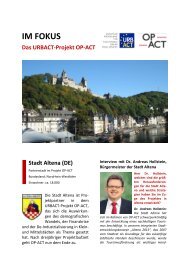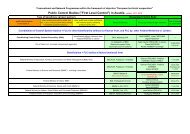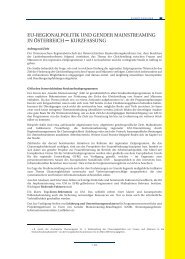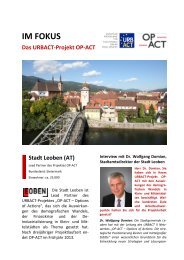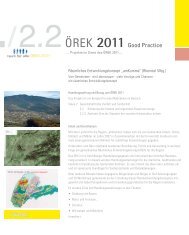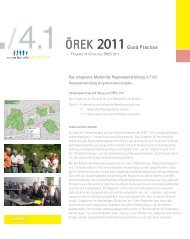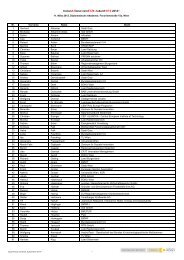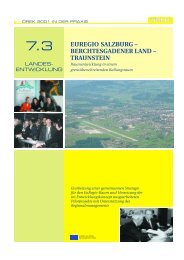Hier klicken - Ãsterreichische Raumordnungskonferenz
Hier klicken - Ãsterreichische Raumordnungskonferenz
Hier klicken - Ãsterreichische Raumordnungskonferenz
Sie wollen auch ein ePaper? Erhöhen Sie die Reichweite Ihrer Titel.
YUMPU macht aus Druck-PDFs automatisch weboptimierte ePaper, die Google liebt.
www.oerok.gv.at<br />
ÖREK 2011<br />
ÖROK ATLAS<br />
STRAT.AT 2020<br />
ALPINE SPACE<br />
CENTRAL EUROPE<br />
SOUTH EAST<br />
EUROPE<br />
Österreichische<br />
<strong>Raumordnungskonferenz</strong><br />
ÖROK: Ziel & Organisation<br />
Die Österreichische <strong>Raumordnungskonferenz</strong> (ÖROK),<br />
1971 gegründet, ist eine von Bund, Ländern und Gemeinden<br />
getragene Einrichtung zur Koordination der Raumentwicklung<br />
auf gesamtstaatlicher Ebene.<br />
Das politische Beschlussorgan umfasst unter dem Vorsitz<br />
des Bundeskanzlers alle BundesministerInnen und Landeshauptleute,<br />
die Präsidenten des Österreichischen Städtebundes<br />
und des Österreichischen Gemeindebundes sowie<br />
mit beratender Stimme auch jene der Wirtschafts- und<br />
Sozialpartner.<br />
Zur Erfüllung ihrer Aufgaben bedient sich die ÖROK auf<br />
Verwaltungsebene einer „Stellvertreterkommission“ sowie<br />
verschiedener Ausschüsse und Arbeitsgruppen, die sich<br />
aus VertreterInnen der Gebietskörperschaften und der<br />
Wirtschafts- und Sozialpartner zusammensetzen.<br />
Neben den formalen Gremien gewinnen weiche „Governance“<br />
Formate für die Arbeit der ÖROK zunehmend an<br />
Bedeutung. Für die laufende Tätigkeit wurde beim Bundeskanzleramt<br />
eine Geschäftsstelle eingerichtet.<br />
ÖROK: Aufgaben & Produkte<br />
Eine der zentralen Aufgaben ist die<br />
Erarbeitung und Veröffentlichung<br />
des Österreichischen Raumentwicklungskonzeptes.<br />
Das aktuelle<br />
Österreichische Raumentwicklungskonzept<br />
(„ÖREK 2011“) ist im Oktober<br />
2011 erschienen.<br />
Zur Umsetzung dieses Konzepts arbeiten<br />
„Umsetzungspartnerschaften“ an konkreten, für<br />
die künftige räumliche Entwicklung Österreichs besonders<br />
relevanten Fragestellungen.<br />
Zu weiteren Kernprodukten<br />
zählen die „ÖROK-<br />
Schriftenreihe“ in der Arbeitsergebnisse<br />
und<br />
Grundlagenstudien publiziert<br />
werden, der „Raumordnungsbericht“<br />
in dem<br />
regelmäßig über raumbezogene<br />
Tätigkeiten von Bund, Ländern und Gemeinden berichtet<br />
wird, sowie die „ÖROK Empfehlungen“ und der „ÖROK<br />
Atlas“.<br />
www.oerok-atlas.at<br />
www.youtube.com/user/oerok2011<br />
ÖROK & Europa<br />
Im Kontext der europäischen<br />
Regional- und Raumentwicklungspolitik<br />
nimmt die ÖROK<br />
seit dem Beitritt Österreichs<br />
zur Europäischen Union eine<br />
wichtige Schnittstellenfunktion<br />
zwischen innerstaatlicher<br />
und europäischer Ebene ein.<br />
Im Bereich der „EU-Kohäsionspolitik“<br />
und „Ländliche Entwicklung“<br />
ist die „Partnerschaftsvereinbarung“<br />
für die Periode 2014–2020<br />
(Arbeitstitel: „STRAT.AT 2020“) in den ÖROK-Strukturen<br />
angesiedelt. Dies erfolgt aufbauend auf den guten Erfahrungen<br />
mit dem Begleitprozess „STRAT.ATplus“ für den<br />
Nationalen Strategischen Rahmenplan 2007-2013.<br />
Als Koordinationsplattform und gemeinsames Sekretariat<br />
für die Begleitausschüsse für regionale Strukturfondsprogramme<br />
Österreichs unterstützt die ÖROK-Geschäftsstelle<br />
die involvierten Partner im Programmzyklus (Programmierung,<br />
Programmverhandlungen, Evaluierung, Programmabschluss,<br />
…).<br />
Die ÖROK-Geschäftsstelle fungiert seit mehreren Jahren<br />
als „National Contact Point“ für transnationale und Netzwerkprogramme<br />
des Ziels „Europäische Territoriale Zusammenarbeit“<br />
(ETZ) mit österreichischer Beteiligung. Der<br />
Fokus der Aktivitäten liegt dabei auf den 3 Programmen<br />
Central Europe, Alpenraum und SEE (South East Europe),<br />
aber auch INTERREG IV C, URBACT II und ESPON werden<br />
betreut. Ergänzt wird dies seit Kurzem durch Koordinationsaufgaben<br />
im Zusammenhang mit den Programmen<br />
der bilateralen grenzüberschreitenden Zusammenarbeit<br />
mit österreichischer Beteiligung innerhalb der ÖROK.<br />
www.oerok.gv.at/eu-regionalpolitik/<br />
www.oerok.gv.at/contact-point/<br />
Impressum:<br />
Herausgeber: Geschäftsstelle der<br />
Österreichischen <strong>Raumordnungskonferenz</strong> (ÖROK)<br />
Für den Inhalt verantwortlich: Mag. Johannes Roßbacher/<br />
Mag. Markus Seidl (Geschäftsführer)<br />
Ballhausplatz 1, A-1010 Wien, Tel: +43 (1) 535 34 44-0,<br />
Fax: +43 (1) 535 34 44-54<br />
E-Mail: oerok@oerok.gv.at; Internet: www.oerok.gv.at<br />
Grafische Gestaltung: www.pflegergrafik.at, Wien<br />
Druck: 02/2012<br />
Fotos: Dr. Peter Görgl, DI Markus Vogl<br />
ÖREK 2011, Cover © Marcus Werres Kommunikationsdesign<br />
Europa Karte: Europäische Kommission
www.oerok.gv.at<br />
ÖREK 2011<br />
ÖROK ATLAS<br />
STRAT.AT 2020<br />
ALPINE SPACE<br />
CENTRAL EUROPE<br />
SOUTH EAST<br />
EUROPE<br />
Austrian Conference<br />
on Spatial Planning<br />
ÖROK: Goal and Organisation<br />
The Austrian Conference on Spatial Planning (ÖROK),<br />
founded in 1971, is an organisation established by the<br />
federal government, the Länder and municipalities to coordinate<br />
spatial development at the national level.<br />
Under the chair of the Federal Chancellor, the members of<br />
the executive body with policymaking powers include all<br />
federal ministers and heads of the Länder, the presidents<br />
of the Austrian Association of Cities and Towns and of the<br />
Austrian Association of Municipalities as well as the heads<br />
of the social and economic partners.<br />
ÖROK uses the services of a Commission of Deputies as well<br />
as several committees and working groups to execute its<br />
tasks at the administrative level that are made up of representatives<br />
of the territorial authorities and the heads of the organisations<br />
representing the social and economic partners.<br />
Apart from the formal bodies, there are a number of soft<br />
“governance” mechanisms that are gaining significance for<br />
ÖROK’s work. An ÖROK Office has been set up at the<br />
Federal Chancellery for operational activities.<br />
ÖROK: Tasks and Products<br />
One of the central areas of work comprises<br />
the drafting and publication of<br />
the Austrian Spatial Development<br />
Concept. The current “Austrian<br />
Spatial Development Concept (ÖREK<br />
2011)” was published in October<br />
2011.<br />
So-called “implementing partnerships”<br />
have been set up to execute the concept. These<br />
partnerships work on concrete themes of special relevance<br />
for spatial development in Austria.<br />
The core products include<br />
the “ÖROK Publication Series”<br />
which covers findings<br />
and basic studies; the “Report<br />
on Spatial Planning”<br />
that periodically reports on<br />
spatially relevant activities<br />
of the federal government,<br />
Länder and municipalities as well as the “ÖROK Recommendations”<br />
and the “ÖROK Atlas”.<br />
www.oerok-atlas.at<br />
www.youtube.com/user/oerok2011<br />
ÖROK and Europe<br />
Within the context of European<br />
regional and spatial development<br />
policies, ÖROK has played<br />
an important role as the coordinating<br />
body between the<br />
internal and the European level<br />
since Austria’s accession to<br />
the European Union.<br />
In the area of “EU Cohesion<br />
Policy” and “Rural Development”,<br />
the “Partnership<br />
Agreement” for the period 2014 to 2020 (Working title:<br />
“STRAT.AT 2020”) is integrated into the organisation of<br />
ÖROK. This decision is based on the good experience made<br />
with the strategic monitoring process “STRAT.ATplus”<br />
within the National Strategic Reference Framework<br />
2007–2013.<br />
ÖROK serves as the Coordination Platform and joint<br />
secretariat for the monitoring committees of the regional<br />
structural fund programmes for Austria and supports the<br />
partners involved in the programming cycle (programming,<br />
negotiations, evaluations, closure, …).<br />
The ÖROK office has served as the “National Contact<br />
Point” for several years for the transnational and network<br />
programmes of the Objective “European Territorial Cooperation”<br />
(ETC) in which Austria participates. The focus of<br />
activities is on three programmes covering Central Europe,<br />
the Alpine Space and SEE (Southeast Europe), but it also<br />
provides support to INTERREG IV C, URBACT II and<br />
ESPON. Additionally, it provides the coordination work for<br />
the programmes of the bilateral cross-border cooperation<br />
with Austrian participation within ÖROK.<br />
www.oerok.gv.at/eu-regionalpolitik/<br />
www.oerok.gv.at/contact-point/<br />
Editorial information:<br />
Publisher: Office of the Austrian Conference on Spatial Planning<br />
(Österreichische <strong>Raumordnungskonferenz</strong>, ÖROK)<br />
Responsible for the contents: Johannes Roßbacher/Markus Seidl<br />
(Managing Director)<br />
Ballhausplatz 1, A-1010 Vienna, Phone: +43 (1) 535 34 44-0,<br />
Fax: +43 (1) 535 34 44-54<br />
E-Mail: oerok@oerok.gv.at; Internet: www.oerok.gv.at<br />
Graphic Design: www.pflegergrafik.at, Vienna<br />
Printed: February 2012<br />
Fotos: Peter Görgl, Markus Vogl<br />
ÖREK 2011, Cover © Marcus Werres Kommunikationsdesign<br />
Map of Europe: European Commission


